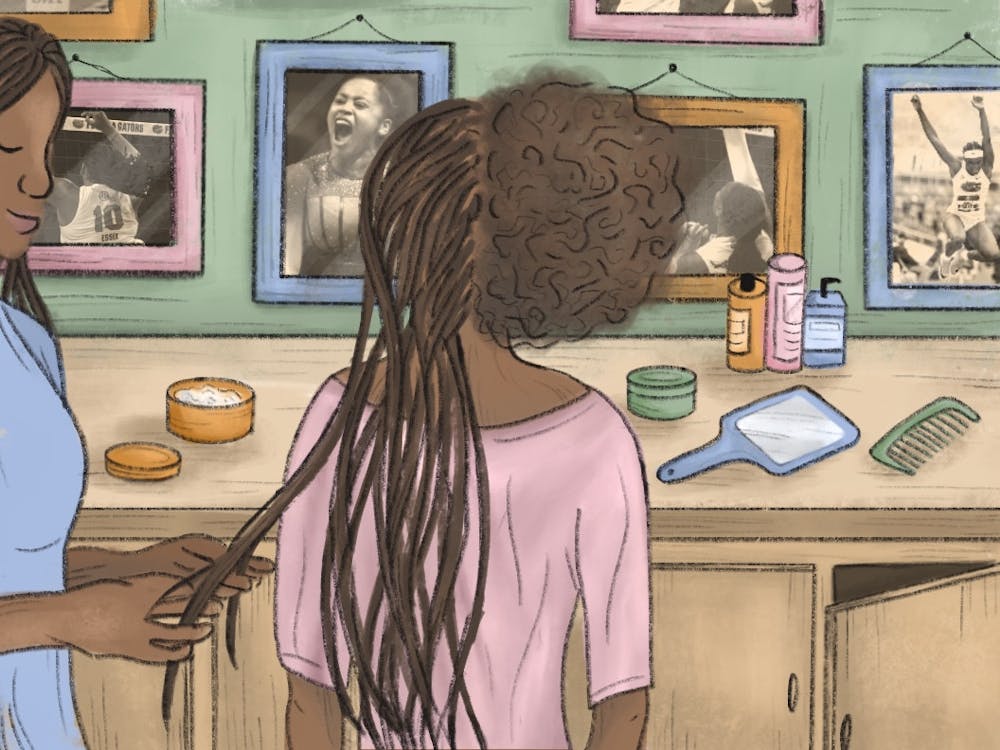Solana Williams couldn’t find any art that looked like her on the walls of the museums she explored. Her only course of action was making it.
“I’ve been enamored with art since I can remember, and probably before,” she said.
The 58-year-old Williston resident has been a full-time artist since 2018, specializing in portraits of Black people. She creates the intricate, varied hairstyles of each person with unconventional materials like sponges, steel wool and cord.
“I think my favorite piece is one of a man with a massive afro, inspired by a man I saw at a civil rights rally in Mobile,” she said. “The best thing I found to capture the texture of his hair was steel wool that I cut up and arranged so it was emerging from the canvas.”
Williams’ interest in painting Black people came from the near constant museum visits she made as a child and teen.
“I went to so many museums and galleries, and the one thing they all had in common was little to no paintings of Black people,” she said.
Even the museums that did feature portraits of Black people in their exhibits tended to center their curation on Black pain, Williams said.
“There’s a crucial difference between representation and meaningful representation,” she said. “It doesn’t matter if every single painting in your gallery has Black people in it if they all paint pictures of Black people as victims or lesser than others.”
Williams worked as a public defender in Monroe County, Alabama, prior to pursuing a full-time career in art.
“Working as a lawyer sounds like the exact opposite of being an artist, and in some ways it is,” she said. “Working in Alabama, though, I saw a lot of overlap between the lack of representation in art and lack of meaningful infrastructure supporting Black people in the justice system.”
Williams continued making art throughout her time as a lawyer as refuge from the high stress and demands of her job. One of her pieces, entitled “Peace,” traveled from Alabama to the Gainesville home of Phyllis Stroud, a 79-year-old art collector, four years ago.
Stroud, an avid painter, said “Peace” was her favorite item in her collection.
“I spent almost eight decades looking at white people being memorialized and celebrated through art, patiently awaiting my turn,” she said. “‘Peace’ gave that to me.”
She said the work meant more to her than just paint on a canvas.
“I’ve seen my people shut out of schools, restaurants and pools my entire life,” she said. “I was tired of seeing us shut out of art too.”
Nonetheless, Williams stressed the fact that Black people haven’t been shut out of art as a whole.
“When I say that Black people don’t exist in art, I mean in the institutions like museums that get acclaim,” she said. “The truth is that Black people are the origins of some of the most beautiful kinds of art that exist outside museums and galleries.”
One example where Black art is welcomed, she said, is in the art of working with hair, a sentiment echoed by DeeDee Jackson, a 26-year-old Ocala hairstylist.
“Doing our hair is art, plain and simple,” Jackson said. “Not just doing hair in complicated styles, but the simple act of taking care of it is art to me.”
Jackson has worked as a professional stylist for seven years, but her love for Black hairstyles started when she was just 5 years old.
“My earliest memory is my mom sitting behind me on the couch and parting my hair to do my little twists,” Jackson said. “It took a few hours, but that was the best time of my week.”
Jackson’s passion for her own hair was often not mirrored by others. She remembers being teased as a young girl by classmates for the thick twists her mother put in her hair and the shiny plastic beads she added to the end.
“People laughed about my hair making noise when I moved,” she said, “or they would pull on them.”
Despite the comments she received about her hair, Jackson said the complexities of Black hair continued to captivate her through her teen years.
“I started doing my friends’ hair in high school,” she said. “Doing hair has always been more than just the hairstyle you end up with. It’s community.”
Like Jackson, Solana Williams sought to find her community when she moved from Alabama to North Central Florida.
“The first thing I did when I moved down here is find a good salon to get my hair done at,” she said. “I spent my time as a lawyer pressing my hair so I looked like the other attorneys around me, but that stopped here. I realized that I had to give myself the same attention and respect I give my paintings.”
Contact Bea Lunardini at blunardini@alligator.org. Follow her on X @bealunardini.






